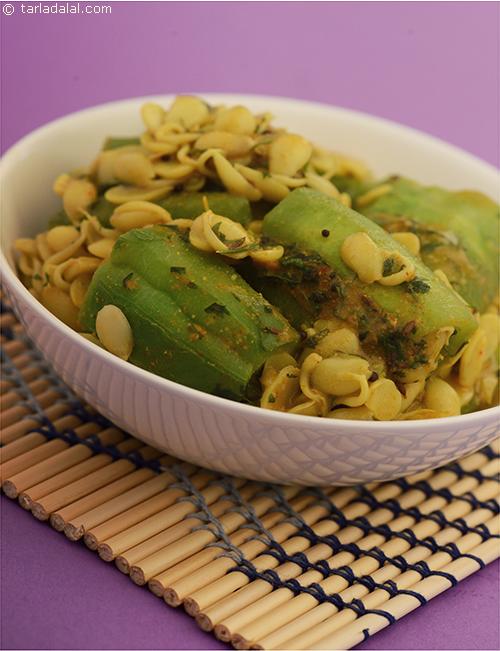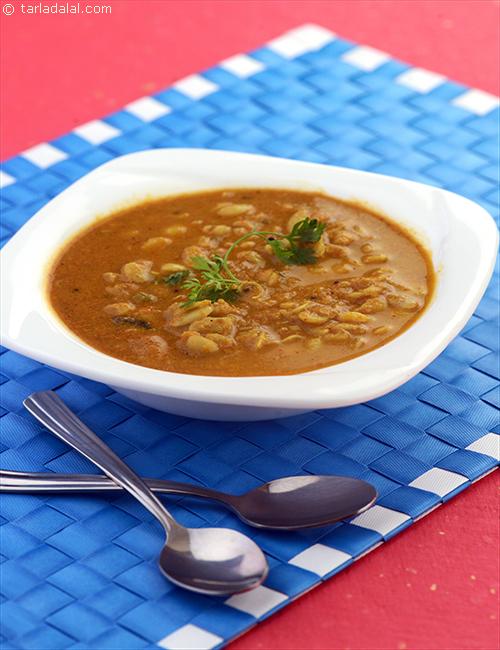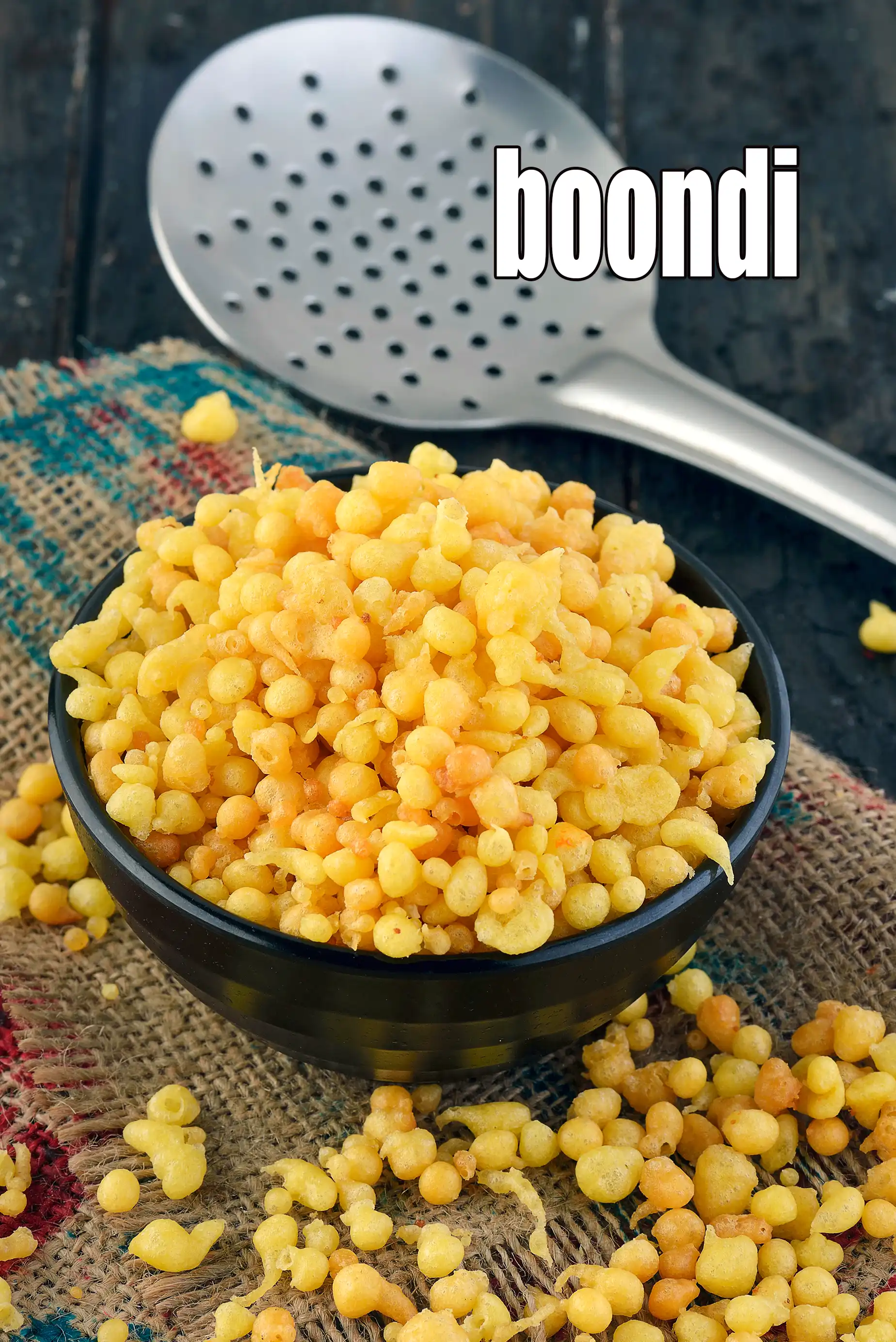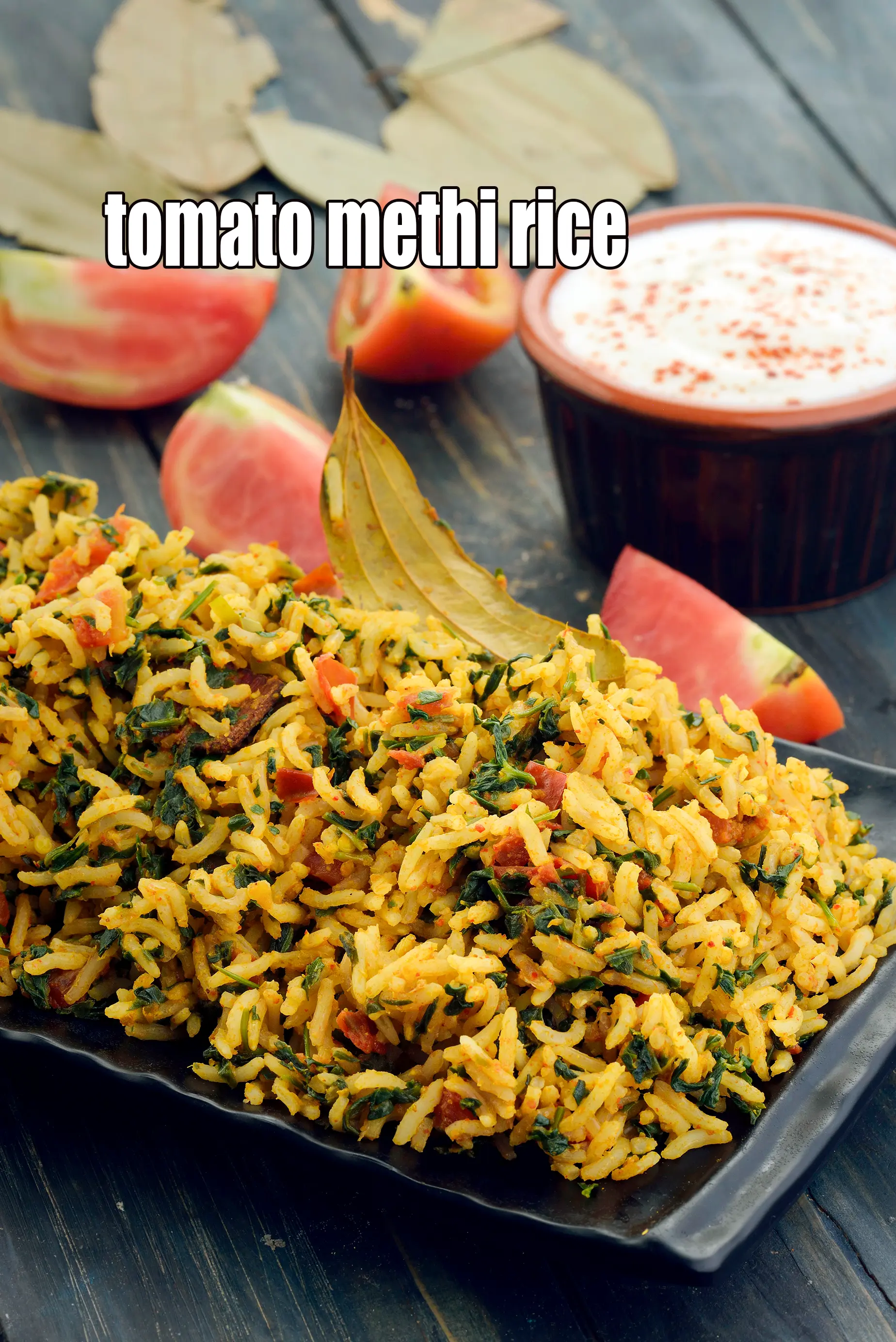You are here: Home> Cuisine > Indian Veg Recipes > Maharashtrian recipes > Maharashtrian Bhaji > Dalimbi Usal, Val Usal, Maharashtrian Vaal
dalimbi usal recipe | val usal | Maharashtrian vaal usal | healthy vaal usal |

Tarla Dalal
04 November, 2022
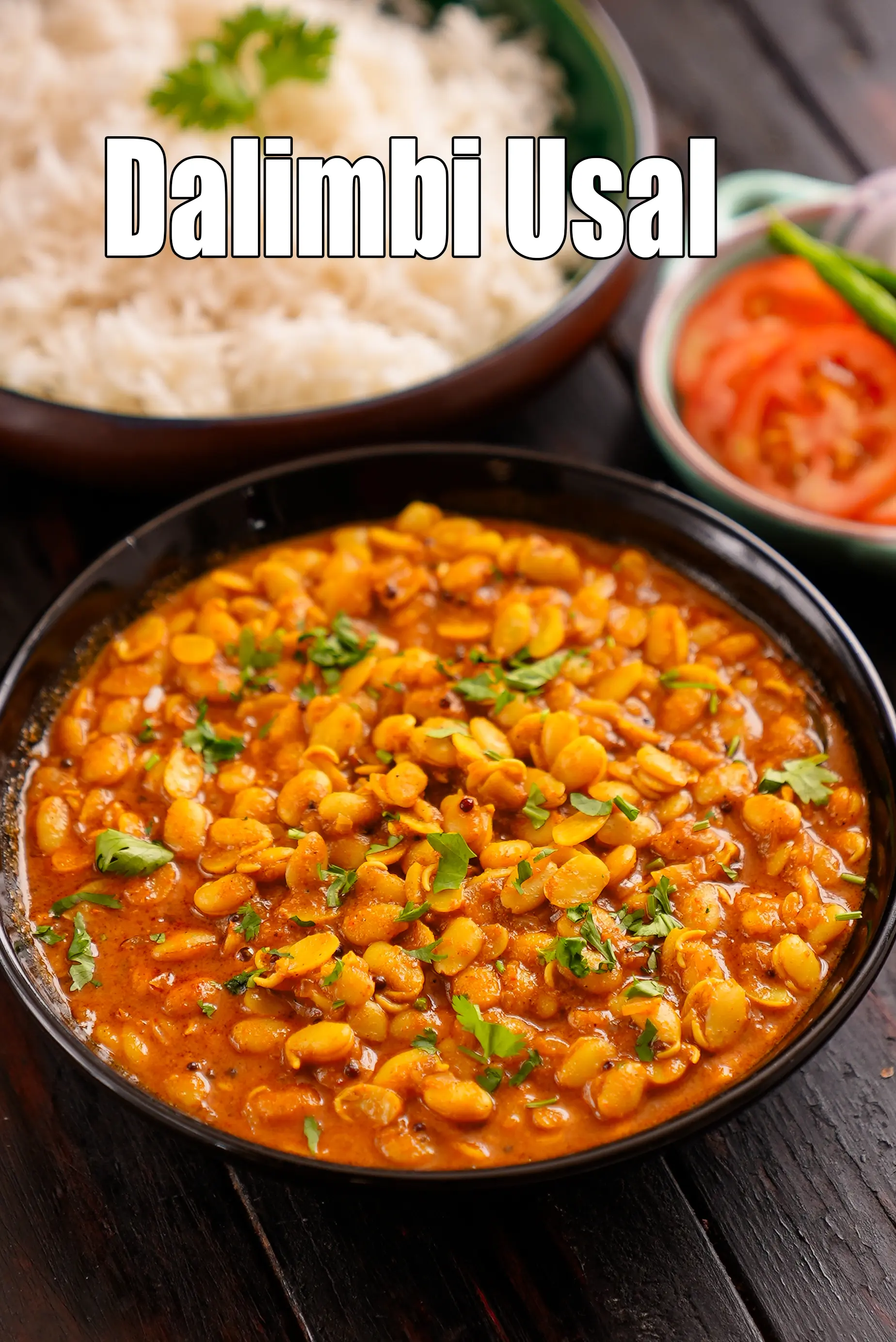
Table of Content
dalimbi usal recipe | val usal | Maharashtrain vaal usal | healthy vaal usal | with 49 amazing images.
valache birde is also popularly known as dalimbi chi usal or vaal usal and is one of the traditional Maharashtrian recipes.
Learn how to make dalimbi usal recipe | val usal | Maharashtrain vaal usal | healthy vaal usal |
Vaal in English is called field beans, butter beans or lima beans. dalimbi usal, is a wholesome and flavorful coconut-based sabzi made with sprouted and peeled vaal.
This is a vegan, protein-rich and delicious vaal usal recipe that pairs best with flatbreads like chapati and paratha. The addition of kokum or tamarind, a tangy fruit, imparts a unique flavor to the curry. Serve along with Chawal Bhakri and Steamed rice for a lip smacking and delicious meal.
pro tips to make dalimbi usal: 1. For a tangy flavour, instead of tamarind pulp you can use kokum to make this recipe. 2. If you do not find malvani masala you can use chilli powder instead.
Enjoy dalimbi usal recipe | val usal | Maharashtrain vaal usal | healthy vaal usal | with detailed step by step photos.
Dalimbi Usal, Val Usal, Maharashtrian Vaal recipe - How to make Dalimbi Usal, Val Usal, Maharashtrian Vaal
Tags
Soaking Time
0
Preparation Time
10 Mins
Cooking Time
18 Mins
Baking Time
0 Mins
Baking Temperature
0
Sprouting Time
0
Total Time
28 Mins
Makes
4 servings
Ingredients
For Dalimbi Usal
2 cups sprouted vaal (field beans/ butter beans) (field beans/ butter beans)
1 tbsp oil
1 tsp mustard seeds ( rai / sarson)
1/4 tsp asafoetida (hing)
10 to 12 curry leaves (kadi patta)
1/2 cup finely chopped onion
1/2 tsp turmeric powder (haldi)
1 1/2 tsp malvani masala
2 tsp coriander-cumin seeds (dhania-jeera) powder
1/2 tsp chilli powder
1 tsp goda masala
1 tbsp tamarind (imli) pulp
salt to taste
2 tbsp finely chopped coriander (dhania)
To Blend Into Masala Paste Using 1/4 Cup Water
1/2 cup roughly chopped tomato
10 to 12 garlic (lehsun) cloves
1 tsp chopped ginger (adrak)
1/4 cup freshly grated coconut
2 tbsp chopped coriander (dhania)
Method
For dalimbi usal
- To make dalimbi usal, heat oil in a deep non-stick pan, add mustard seeds, asafoetida, curry leaves and onions.
- Sauté on a medium flame for 2 to 3 minutes. Add the vaal, turmeric powder, malvani masala, coriander cumin seeds powder, chilli powder, goda masala and salt to taste.
- Mix well and cook on a medium flame for 2 to 3 minutes, until the raw smell of vaal goes off.
- Add the prepared masala paste, tamarind pulp and 1½ cups of hot water.
- Mix well and cover and cook on a medium flame for 10 to 12 minutes, while stirring occasionally.
- Serve the dalimbi usal hot garnished with coriander.
Dalimbi Usal, Val Usal, Maharashtrian Vaal recipe with step by step photos
-
-
Like dalimbi usal recipe | val usal | Maharashtrain vaal usal | healthy vaal usal | then do try other usal recipes also:
- usal recipe | Maharashtrian usal | traditional Kolhapuri misal | Puneeri misal |
- Malvani vatana usal recipe | kala vatana usal | Malvani vatana gravy |
-
Like dalimbi usal recipe | val usal | Maharashtrain vaal usal | healthy vaal usal | then do try other usal recipes also:
-
-
See the below image of list of ingredients for making dalimbi usal recipe.

![]()
-
See the below image of list of ingredients for making dalimbi usal recipe.
-
-
The easiest way to use sprouted is buy sprouted vaal. These are easily available in your local markets. Given below is a detailed step by step on how to sprout vaal for those who love to do it as it is time consuming and takes over 2 days.

![]()
-
This is what vaal ( lima beans, butter beans ) looks like.
-2-195928.webp)
![]()
-
Place vaal in a bowl. We have used 1 1/2 cups vaal to make 3 cups sprouted vaal.
-3-195928.webp)
![]()
-
Cover with enough water.
-4-195928.webp)
![]()
-
Cover and soak vaal ( lima beans ) for 15 hours in plenty of warm water.
-5-195928.webp)
![]()
-
Vaal or lima beans look like this after soaking.
-6-195928.webp)
![]()
-
Drain.
-7-195928.webp)
![]()
-
Place the soaked and drained vaal ( lima beans ) in a damp cheese cloth and leave to sprout for 24 hours. Note that 12 hours is not enough to sprout. Ensure that there is a little bit of water at the bottom of the bowl so that the vaal will use it to sprout.
-8-195928.webp)
![]()
-
Add 1/4 cup water over the vaal. That ensure the muslin cloth stays damp and there is enough water at the base of the bowl through the 24 hours to enable sprouting.
-9-195928.webp)
![]()
-
Tie the muslin cloth well and cover with a lid for 24 hours.
-10-195928.webp)
![]()
-
Our vaal ( butter beans, lima beans ) is now sprouted after 24 hours.
-11-195928.webp)
![]()
-
Put the sprouted vaal in a bowl full of water as we going to peel them.
-12-195928.webp)
![]()
-
Peel the sprouted vaal with your fingers. You have to let the beans be in the water and take out the skin and discard in a seperate plate. Discard any beans that are discoloured. Peeeling does take time and patience.
-13-195928.webp)
![]()
-
Wash and drain the vaal. This is required as we have sprouted the beans for 24 hours.
-14-195928.webp)
![]()
-
Your sprouted vaal is ready to be used in a Gujarati sabzi.
-15-195928.webp)
![]()
-
The easiest way to use sprouted is buy sprouted vaal. These are easily available in your local markets. Given below is a detailed step by step on how to sprout vaal for those who love to do it as it is time consuming and takes over 2 days.
-
-
Vaal ( lima beans ) is a storehouse of protein and fibre. The duo of these nutrients makes you feel full for longer, helping cut unnecessary food intake and weight gain. The fibre also aids digestion and maintains digestive health. Beans also appear to have a blood sugar normalizing effect, and may be of benefit to diabetics. The zinc in this dal acts as an antioxidant and helps to protect against cancer and fatigue. They also abound in vitamin B1 which has a role to play in nerve functioning. Upon sprouting, they vitamins and minerals increase manifold.

![]()
-
Vaal ( lima beans ) is a storehouse of protein and fibre. The duo of these nutrients makes you feel full for longer, helping cut unnecessary food intake and weight gain. The fibre also aids digestion and maintains digestive health. Beans also appear to have a blood sugar normalizing effect, and may be of benefit to diabetics. The zinc in this dal acts as an antioxidant and helps to protect against cancer and fatigue. They also abound in vitamin B1 which has a role to play in nerve functioning. Upon sprouting, they vitamins and minerals increase manifold.
-
-
In a mixer jar, add ½ cup roughly chopped tomatoes. tomatoes break down and release their natural juices, contributing to the sauce's thickness and richness. This creates a smooth and velvety texture that coats the beans perfectly.

![]()
-
Add 10 to 12 garlic cloves. Garlic has a strong, pungent flavor that can enhance the overall taste of the dish.

![]()
-
Add 1 tsp chopped ginger. Ginger is used in dalimbi usal recipe to enhance the flavor and aroma of the dish.

![]()
-
Add 1 green chilli.

![]()
-
Add 2 tbsp chopped coriander. Coriander is a versatile herb that adds a bright, citrusy flavor to dishes.

![]()
-
Add ¼ cup freshly grated coconut. The grated coconut adds a creamy texture to the dish, making it more indulgent.

![]()
-
Add ¼ cup water.

![]()
-
Blend into a smooth paste. Keep aside.
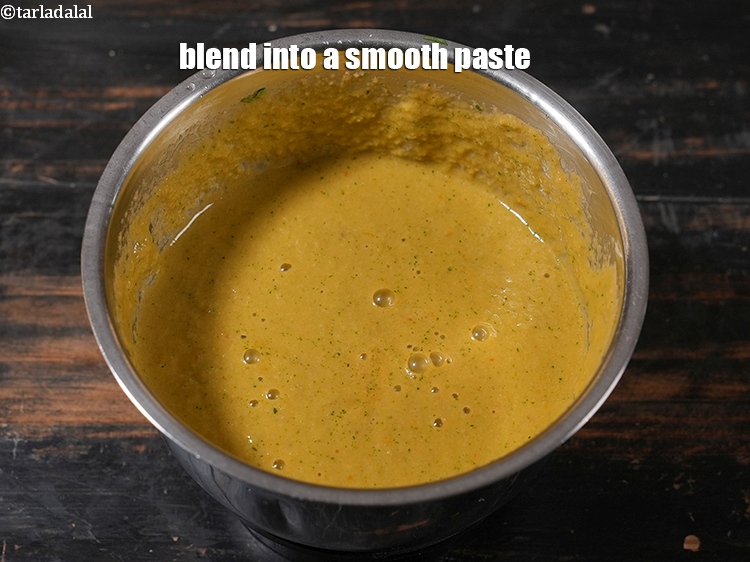
![]()
-
In a mixer jar, add ½ cup roughly chopped tomatoes. tomatoes break down and release their natural juices, contributing to the sauce's thickness and richness. This creates a smooth and velvety texture that coats the beans perfectly.
-
-
To make dalimbi usal recipe | val usal | Maharashtrain vaal usal | healthy vaal usal | heat 2 tbsp oil in a deep non-stick pan.

![]()
-
Add 1 tsp mustard seeds.

![]()
-
Add ¼ tsp asafoetida.

![]()
-
Add 10 to 12 curry leaves. Curry leaves in Dalimbi Usal add a unique flavor and aroma to the dish.

![]()
-
Add ½ cup finely chopped onions. Sautéed onions release aromatic compounds that contribute to the overall fragrance of the Dalimbi Usal.

![]()
-
Sauté on a medium flame for 2 to 3 minutes.

![]()
-
Add 2 cups sprouted and peeled vaal.

![]()
-
Add ½ tsp turmeric powder.

![]()
-
Add 1½ tsp malvani masala. Malvani masala is a blend of spices that is commonly used in Maharashtrian cuisine. If you don't have malvani masala on hand, you can substitute it with a chilli powder.

![]()
- Add 2 tsp coriander cumin seeds powder.
-
Add ½ tsp chilli powder. It adds a level of heat that can be adjusted to your preference.
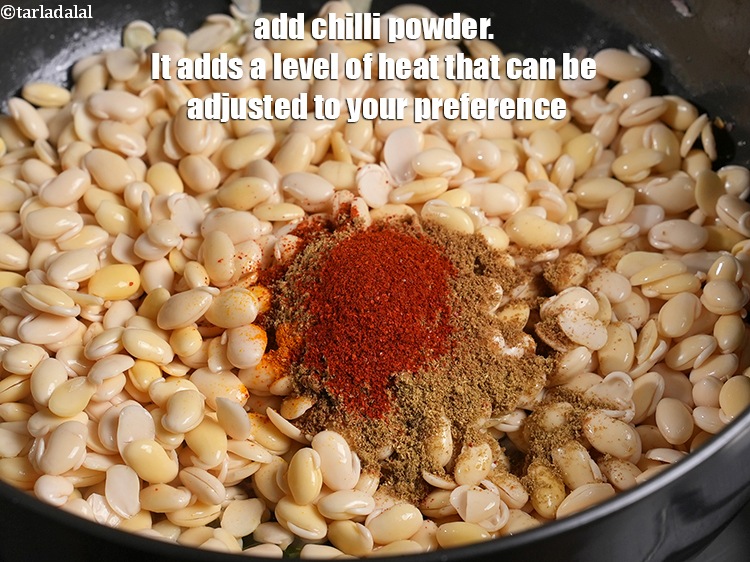
![]()
-
Add 1 tsp goda masala.
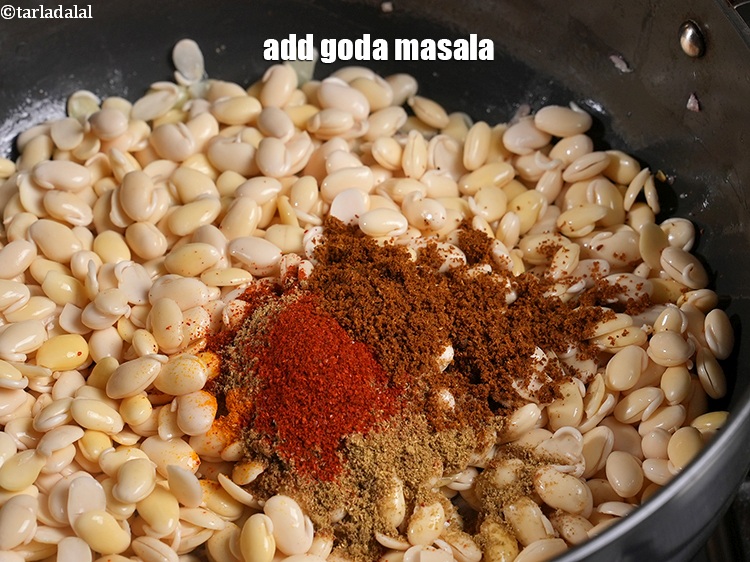
![]()
-
Add salt to taste.

![]()
-
Mix well and cook on a medium flame for 2 to 3 minutes, until the raw smell of vaal goes off.

![]()
-
Add the prepared masala paste.

![]()
-
Add 1 tbsp tamarind pulp. Tamarind pulp imparts a distinct tangy flavor to the Vaal Usal. This tanginess balances the richness of the sprouted beans and other ingredients, creating a harmonious taste profile.

![]()
-
Add 1½ cups of hot water.

![]()
-
Mix well and cover and cook on a medium flame for 10 to 12 minutes, while stirring occasionally.

![]()
-
Serve the dalimbi usal recipe | val usal | Maharashtrain vaal usal | healthy vaal usal | hot garnished with coriander.

![]()
-
Dalimbi usal recipe is best served with rice bhakri or steamed rice.
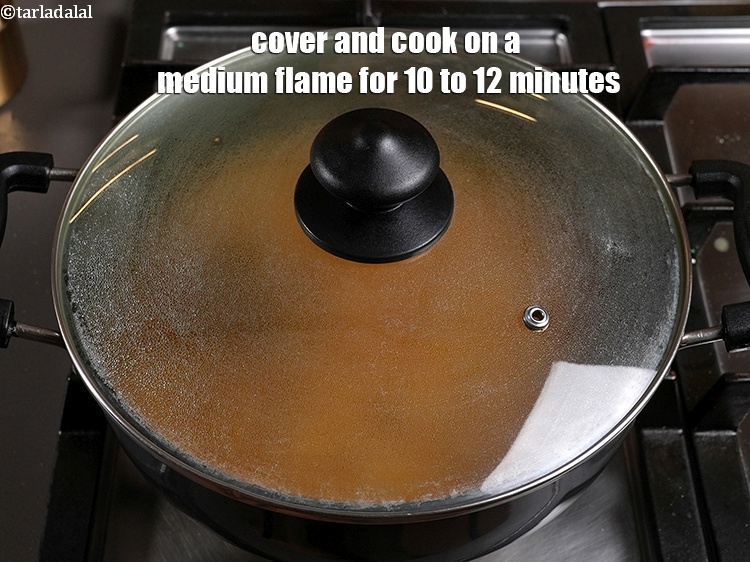
![]()
-
To make dalimbi usal recipe | val usal | Maharashtrain vaal usal | healthy vaal usal | heat 2 tbsp oil in a deep non-stick pan.
-
-
For a tangy flavour, instead of tamarind pulp you can use kokum to make this recipe.

![]()
-
If you do not find malvani masala you can use chilli powder instead.

![]()
-
This is the Malavani masala we used.

![]()
-
Dalimbi Usal is rich in Phosphorus, Fiber, Magnesium, Thiamine, Protein.
- Phosphorus : Phosphorus works closely with calcium to build bones. 49% of RDA.
- Fiber : Dietary fiber reduce the risk of heart disease, prevent the spike in blood sugar levels and hence super for diabetics. Consume more fruits, vegetables, moong, oats, matki, whole grains. 49% of RDA.
- Magnesium : Magnesium is required for formation of bones and teeth. It helps in the metabolism of calcium and potassium. % of RDA. magnesium rich Indian foods like leafy vegetables (palak, broccoli, kale), pulses ( rajma, chawli, moong ), nuts (walnuts, almonds) , cereals ( jowar, bajra, whole wheat flour, dalia). 42% of RDA.
- Vitamin B1 (Thiamine) : Vitamin B1 protects nerves, helps in carbohydrate metabolism, prevents heart diseases and helps produce red blood cells. 40% of RDA.
- Protein : Protein is required for the managing the wear and tear of all cells of the body. Have protein rich Indian foods like paneer, curd, Greek yoghurt, tofu, almonds, sprouts, chana, rajma, chick peas, quinoa, buckwheat ). 30% of RDA.

![]()
-
For a tangy flavour, instead of tamarind pulp you can use kokum to make this recipe.
-
-
Dalimbi Usal is rich in below macronutrients, vitamins and minerals given in descending order (highest to lowest).
{ad5}
- Phosphorus : Phosphorus works closely with calcium to build bones. 35% of RDA.
- Fiber : Dietary fiber reduce the risk of heart disease, prevent the spike in blood sugar levels and hence super for diabetics. Consume more fruits, vegetables, moong, oats, matki, whole grains. 38% of RDA.
- Vitamin B1 (Thiamine) : Vitamin B1 protects nerves, helps in carbohydrate metabolism, prevents heart diseases and helps produce red blood cells. 30% of RDA.
- Magnesium : Magnesium is required for formation of bones and teeth. It helps in the metabolism of calcium and potassium. % of RDA. magnesium rich Indian foods like leafy vegetables (palak, broccoli, kale), pulses ( rajma, chawli, moong ), nuts (walnuts, almonds) , cereals ( jowar, bajra, whole wheat flour, dalia). 29% of RDA.
- Protein : Protein is required for the managing the wear and tear of all cells of the body. Have protein rich Indian foods like paneer, curd, Greek yoghurt, tofu, almonds, sprouts, chana, rajma, chick peas, quinoa, buckwheat ). 21% of RDA.

![]()
-
Dalimbi Usal is rich in below macronutrients, vitamins and minerals given in descending order (highest to lowest).
{ad5}
Nutrient values (Abbrv)per plate
| Energy | 227 cal |
| Protein | 11.3 g |
| Carbohydrates | 31.7 g |
| Fiber | 9.4 g |
| Fat | 6.8 g |
| Cholesterol | 0 mg |
| Sodium | 14.6 mg |
Click here to view Calories for Dalimbi Usal, Val Usal, Maharashtrian Vaal
The Nutrient info is complete

Asari
May 12, 2022, 5:06 p.m.
Dalimbi usal.. the usal is perfectly spiced up.. and balanced taste with little sweetness and sourness.. I enjoyed this with bhakri.. I have loved this recipe..

Sharmila Shahade
June 27, 2021, 5:15 a.m.
I tried the recipe and it came out really well. I added very little milk (about 2 tbspn)in the end to cut the sharpness of the vaal . Also added 2-3 tspn grated coconut and a small piece of potato ( mashed enevenly by hand ) to the gravy to slightly thicken the gravy.

P. V. Sawant
Oct. 1, 2020, 11:28 a.m.
Very easy and delightful to make this recipe.

Tarla Dalal
Oct. 1, 2020, 11:28 a.m.
Thanks so much for trying our recipe, it means a lot to us. Keep trying more recipes and sharing your feedback with us.

Foodie #569301
July 26, 2019, 6:57 p.m.
Simple yet nice

suresh
Jan. 30, 2012, 8:06 p.m.
is coraiander seeds to be used of fresh corainder leaves?

Tarla Dalal
Jan. 30, 2012, 8:06 p.m.
Hi Suresh, As mentioned in the recipe, chopped coriander is to be used.

